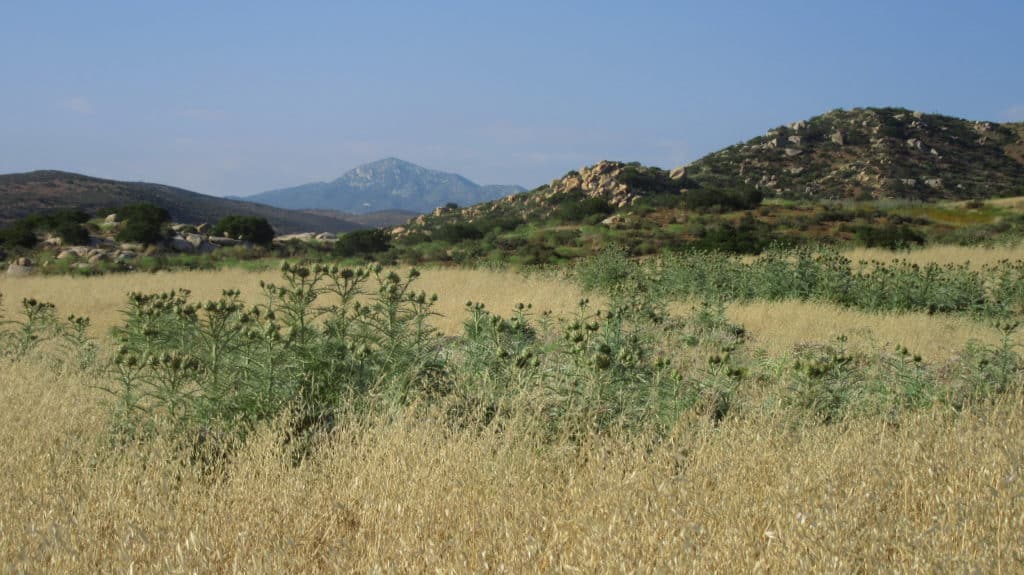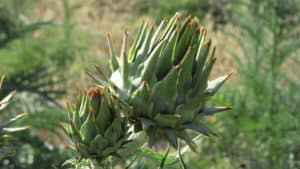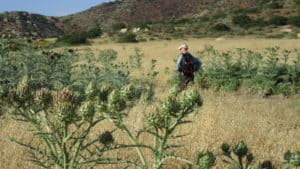Wild Artichokes
 Wild artichokes permeate the wilderness of Southern California, a region whose climate is similar to that of the Mediterranean.
Wild artichokes permeate the wilderness of Southern California, a region whose climate is similar to that of the Mediterranean.
For many years we have ridden our mountain bikes past several stands of artichokes in their various stages. In late winter you’d see stalks bereft of flowers. Then in spring a bunch of spiky bulbs lolled on their stems. By summer the bulbs would burst with purple blooms. After that, the stands of chokes looked dead and depleted, the bulbs drooping with white fluff.
We’d say, “We’ve got to cook up one of these babies and see how it actually tastes when it’s the right season.”
Advice From Feral Kevin
 So this year, we actually did it. May seems to be the “right season.” We stopped at a massive grove of chokes to chop off two of the sharp, pointy bulbs. We wrapped them in a windbreaker and stuffed them into Mark’s Camelbak. Later that night, we found a Youtube video that explained how to prepare wild artichokes. The guy in the video, who calls himself Feral Kevin, effusively praised not only the flavor but the fact that such a gourmet delicacy was FREE for the taking.
So this year, we actually did it. May seems to be the “right season.” We stopped at a massive grove of chokes to chop off two of the sharp, pointy bulbs. We wrapped them in a windbreaker and stuffed them into Mark’s Camelbak. Later that night, we found a Youtube video that explained how to prepare wild artichokes. The guy in the video, who calls himself Feral Kevin, effusively praised not only the flavor but the fact that such a gourmet delicacy was FREE for the taking.
Feral Kevin grows both commercial and wild artichokes in the same habitat. “The gophers don’t touch the wild artichokes,” he says, “and they are aphid and ant free as well. Did I mention that I never have to water them and they grow for many years and are showy and beautiful like an ornamental cactus?”
Kitchen Shenanigans
Back in our kitchen, Mark cut off the spiked ends of the leaves and placed the chokes in a pot with about half an inch of water. Then he drizzled the wild artichokes with olive oil and lemon juice, and sprinkled them with minced garlic. Every fifteen minutes, Mark doused the chokes with their own juices via a turkey baster. It took about an hour for them to tenderize in the steaming water.
Then Voila, it was time for the Taste Test. Our friend, Megan, had crashed on her mountain bike – TWICE. She needed pampering. So we let her fall upon the artichokes like a starving wolf. We immediately wished we had harvested a few more of these tasty gems. The jury was in; yes, wild artichokes taste GOOD. The heart is firmer and more shallow than the artichokes you find at a farmer’s market, and the leaves sharper, but the meat is tasty.
Pest or Delicacy?
I googled the wild artichokes of California. I was intrigued to learn that the Spanish introduced artichokes to California in the 1700’s. Even MORE intriguing? Throughout the 1980’s the State of California spent hundreds of thousands of dollars to eradicate the plant. They considered it a “pest” because cows aren’t attracted to eating it and have a hard time moving past the sharp points. A 1987 Los Angeles Times article comes up first on Google when you search for “wild artichokes California.” In it, you learn:
“We’ve been spending $100,000 a year for more years than I can remember trying to get rid of the stuff,” said Gilbert G. Aguirre, vice president of operations for the 40,000-acre Rancho Mission Viejo, where the plant–with its feathery white seed pods–was once referred to as “Mission Viejo snow.”
Yo Foodies!
Well, hello, I thought to myself, just mention to a bunch of foodies that this plant is not only edible but delicious – and FREE. Your problem is solved without spending a cent. Because if you chop off the heads of the plant before they flower and spread their white fluff (containing the seeds) then they will not multiply.
So fast forwarding to now, are people still so unaware of how wonderful these little artichokes taste? Scrolling down in my Google search, I found an Italian company that sells jars of baby wild artichokes for 11 Euros. That’s around $13 U.S. Additional articles about wild artichokes reveal that true foodies are now more appreciative of the Wild Artichoke, aka Cynara cardunculus, cardoon, or artichoke thistle. Funny how it was considered a “pest” for so many years and has now finally built up a reputation as a tasty delicacy. These days, California finally appreciates the little bugger.


